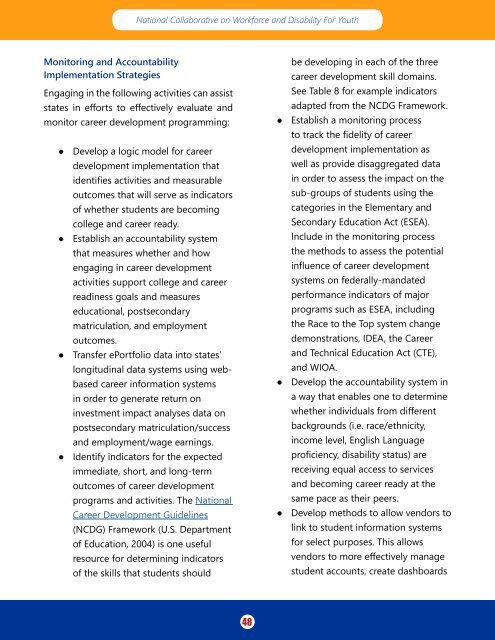Designing Statewide Strategies & Programs
DesigningStatewideCareerDevelopmentStrategiesProgramsPub_0
DesigningStatewideCareerDevelopmentStrategiesProgramsPub_0
You also want an ePaper? Increase the reach of your titles
YUMPU automatically turns print PDFs into web optimized ePapers that Google loves.
National Collaborative on Workforce and Disability For Youth<br />
Monitoring and Accountability<br />
Implementation <strong>Strategies</strong><br />
Engaging in the following activities can assist<br />
states in efforts to effectively evaluate and<br />
monitor career development programming:<br />
●●<br />
●●<br />
●●<br />
●●<br />
Develop a logic model for career<br />
development implementation that<br />
identifies activities and measurable<br />
outcomes that will serve as indicators<br />
of whether students are becoming<br />
college and career ready.<br />
Establish an accountability system<br />
that measures whether and how<br />
engaging in career development<br />
activities support college and career<br />
readiness goals and measures<br />
educational, postsecondary<br />
matriculation, and employment<br />
outcomes.<br />
Transfer ePortfolio data into states’<br />
longitudinal data systems using webbased<br />
career information systems<br />
in order to generate return on<br />
investment impact analyses data on<br />
postsecondary matriculation/success<br />
and employment/wage earnings.<br />
Identify indicators for the expected<br />
immediate, short, and long-term<br />
outcomes of career development<br />
programs and activities. The National<br />
Career Development Guidelines<br />
(NCDG) Framework (U.S. Department<br />
of Education, 2004) is one useful<br />
resource for determining indicators<br />
of the skills that students should<br />
●●<br />
●●<br />
●●<br />
be developing in each of the three<br />
career development skill domains.<br />
See Table 8 for example indicators<br />
adapted from the NCDG Framework.<br />
Establish a monitoring process<br />
to track the fidelity of career<br />
development implementation as<br />
well as provide disaggregated data<br />
in order to assess the impact on the<br />
sub-groups of students using the<br />
categories in the Elementary and<br />
Secondary Education Act (ESEA).<br />
Include in the monitoring process<br />
the methods to assess the potential<br />
influence of career development<br />
systems on federally-mandated<br />
performance indicators of major<br />
programs such as ESEA, including<br />
the Race to the Top system change<br />
demonstrations, IDEA, the Career<br />
and Technical Education Act (CTE),<br />
and WIOA.<br />
Develop the accountability system in<br />
a way that enables one to determine<br />
whether individuals from different<br />
backgrounds (i.e. race/ethnicity,<br />
income level, English Language<br />
proficiency, disability status) are<br />
receiving equal access to services<br />
and becoming career ready at the<br />
same pace as their peers.<br />
Develop methods to allow vendors to<br />
link to student information systems<br />
for select purposes. This allows<br />
vendors to more effectively manage<br />
student accounts, create dashboards<br />
48


